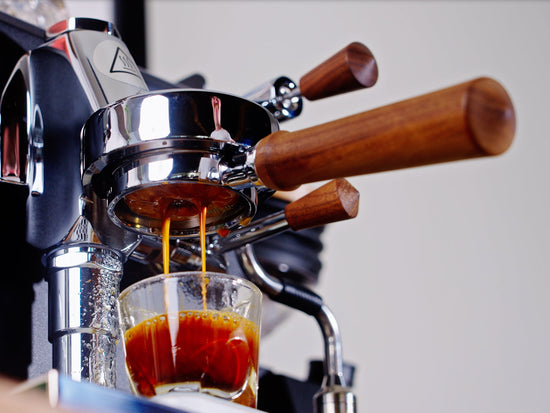What Does Channeling Look Like?

Channeling is the uninvited guest at every espresso bar. It shows up unannounced, makes a mess of your countertop (in the worst cases, your crisp white tee), and leaves your espresso tasting off. Whether you're new to espresso or have been chasing the elusive god shot for years, you've probably encountered it, sometimes without even realizing it. Can we always see channeling? Or, are there more cracks under the surface yet unseen? So what exactly does channeling look like? And when should you be worried? Let's solve this together.
What You Can See: The Visible Signs of Channeling
Despite being caused by fairly straightforward physical phenomena, such as water under pressure finding the path of least resistance, channeling can take on various unsightly forms. The ones that are easiest to spot are, as always, the hardest to ignore. Think gushers, errant jets of coffee spraying every which way—not a good time, especially for the clean freaks.
-
Uneven First Drops
One of the most telling signs of channeling happens right at the beginning of your shot. Ideally, you'll see espresso begin to drip from the entire bottom surface of your portafilter basket at roughly the same time. Sometimes this drip begins slowly, eventually forming into several streams of even flowing liquid that coalesce into a singular stream. However, it doesn't always look as tidy as this. Some precision baskets, such as the Weber Workshops Unibasket, can often look like a shower with several streams of liquid for the entire extraction process.
If, instead, some areas are gushing while others are dry, you've most likely got channels forming. Those high-flow areas are over-extracting, while the low-flow areas contribute minimal flavor and body to the final cup.
Is it the end of the world? Not necessarily. Even great shots often show some slight unevenness in the first few seconds. But if the disparity is dramatic, you'll probably taste it.
-
Persistent Gaps in Flow

Suppose those uneven first drops continue into the middle of the extraction period, and you start seeing clear bald spots in the basket (areas of the basket that just aren't getting any flow). In that case, you're likely dealing with serious channeling. These gaps in flow correlate with bitter, hollow, or just plain strange-tasting shots. You thought that sour shots were the worst? Try ashy, woody, and chalky. Gross. While a visible rough start can sometimes even out, it's safe to say that if your entire extraction has gaps in flow, your extraction is vastly uneven.
Pro Tip: We usually encourage new home baristas to taste (not drink) every shot they pull, but as you gain more experience, you can discern which shots you can toss down the drain. Take a deep breath, keep a crisp Topo Chico handy, cleanse your palate, and repeat.
-
Espresso Jets

If you've ever been splattered by a rogue stream of espresso shooting out at a 45-degree angle, you've met the most dramatic symptom of channeling: jets. Jets and errant sprays are caused by espresso finding a tiny, high-pressure path through the puck, sometimes made worse by fine particles blocking a basket hole.
A single jet isn't necessarily a crisis. Sometimes these forceful spurts happen even on great-tasting shots. However, if you're seeing or wearing them consistently, you may want to look closer at your puck prep routine and make some adjustments before you step up to the plate for your next shot. For the most part, though, jets aren't something to raise hell over.
-
Cracked Pucks

This one's extremely tricky, and having a healthy skepticism with it is good. Many home baristas worry when they see a cracked or cratered puck after a shot, but we encourage skepticism here. A puck's surface can be misleading, an unreliable narrator, if you will. Unless you see consistent signs: holes, channels, or craters every time, it's not something to lose sleep over.
We recently covered this topic in a video about soggy pucks: what really matters is how the espresso tastes.
What You Can't See: The Taste of Channeling

Can you see channeling in the photo above? No? Neither can we. Even if you don't see jets or gaps in flow, channeling still has a way of showing up in the cup. That's because areas of the puck that don't get much flow contribute very little to the final shot, dragging down your overall extraction. Channeling can be measured directly with a refractometer, but most people don't have this tool in their kitchen drawer. If you're using a refractometer, you might see a shot with channeling show lower total extraction than otherwise identical shots. But for most of us, the best diagnostic tool is built-in: your tongue.
Shots that suffer from channeling tend to taste muddier, more acrid, and less balanced. They'll have a weird mix of sour and bitter, classic signs of under- and over-extraction happening simultaneously.
We've all pulled shots that looked like a disaster but tasted surprisingly good. If it tastes great, it is great. That's all that matters at the end of the day.
Should You Worry?

Channeling happens. It's frustrating, sure, but it's not a moral failing. Even with the best puck prep in the world, no one is pulling perfect shots every single time. Still, sometimes it just happens, and that's okay. At Clive, we believe the key is to keep learning, taste everything (within reason), and try not to get too caught up in perfection. Cheers!